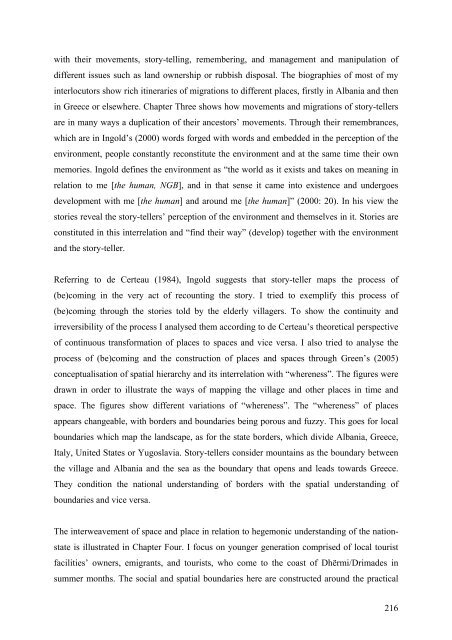university of nova gorica graduate school contested spaces and ...
university of nova gorica graduate school contested spaces and ...
university of nova gorica graduate school contested spaces and ...
You also want an ePaper? Increase the reach of your titles
YUMPU automatically turns print PDFs into web optimized ePapers that Google loves.
with their movements, story-telling, remembering, <strong>and</strong> management <strong>and</strong> manipulation <strong>of</strong><br />
different issues such as l<strong>and</strong> ownership or rubbish disposal. The biographies <strong>of</strong> most <strong>of</strong> my<br />
interlocutors show rich itineraries <strong>of</strong> migrations to different places, firstly in Albania <strong>and</strong> then<br />
in Greece or elsewhere. Chapter Three shows how movements <strong>and</strong> migrations <strong>of</strong> story-tellers<br />
are in many ways a duplication <strong>of</strong> their ancestors’ movements. Through their remembrances,<br />
which are in Ingold’s (2000) words forged with words <strong>and</strong> embedded in the perception <strong>of</strong> the<br />
environment, people constantly reconstitute the environment <strong>and</strong> at the same time their own<br />
memories. Ingold defines the environment as “the world as it exists <strong>and</strong> takes on meaning in<br />
relation to me [the human, NGB], <strong>and</strong> in that sense it came into existence <strong>and</strong> undergoes<br />
development with me [the human] <strong>and</strong> around me [the human]” (2000: 20). In his view the<br />
stories reveal the story-tellers’ perception <strong>of</strong> the environment <strong>and</strong> themselves in it. Stories are<br />
constituted in this interrelation <strong>and</strong> “find their way” (develop) together with the environment<br />
<strong>and</strong> the story-teller.<br />
Referring to de Certeau (1984), Ingold suggests that story-teller maps the process <strong>of</strong><br />
(be)coming in the very act <strong>of</strong> recounting the story. I tried to exemplify this process <strong>of</strong><br />
(be)coming through the stories told by the elderly villagers. To show the continuity <strong>and</strong><br />
irreversibility <strong>of</strong> the process I analysed them according to de Certeau’s theoretical perspective<br />
<strong>of</strong> continuous transformation <strong>of</strong> places to <strong>spaces</strong> <strong>and</strong> vice versa. I also tried to analyse the<br />
process <strong>of</strong> (be)coming <strong>and</strong> the construction <strong>of</strong> places <strong>and</strong> <strong>spaces</strong> through Green’s (2005)<br />
conceptualisation <strong>of</strong> spatial hierarchy <strong>and</strong> its interrelation with “whereness”. The figures were<br />
drawn in order to illustrate the ways <strong>of</strong> mapping the village <strong>and</strong> other places in time <strong>and</strong><br />
space. The figures show different variations <strong>of</strong> “whereness”. The “whereness” <strong>of</strong> places<br />
appears changeable, with borders <strong>and</strong> boundaries being porous <strong>and</strong> fuzzy. This goes for local<br />
boundaries which map the l<strong>and</strong>scape, as for the state borders, which divide Albania, Greece,<br />
Italy, United States or Yugoslavia. Story-tellers consider mountains as the boundary between<br />
the village <strong>and</strong> Albania <strong>and</strong> the sea as the boundary that opens <strong>and</strong> leads towards Greece.<br />
They condition the national underst<strong>and</strong>ing <strong>of</strong> borders with the spatial underst<strong>and</strong>ing <strong>of</strong><br />
boundaries <strong>and</strong> vice versa.<br />
The interweavement <strong>of</strong> space <strong>and</strong> place in relation to hegemonic underst<strong>and</strong>ing <strong>of</strong> the nationstate<br />
is illustrated in Chapter Four. I focus on younger generation comprised <strong>of</strong> local tourist<br />
facilities’ owners, emigrants, <strong>and</strong> tourists, who come to the coast <strong>of</strong> Dhërmi/Drimades in<br />
summer months. The social <strong>and</strong> spatial boundaries here are constructed around the practical<br />
216

















